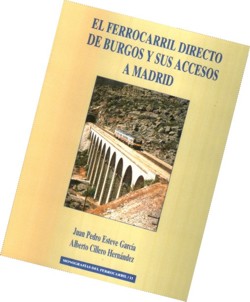11.- El Ferrocarril Directo de Burgos y sus accesos a Madrid
(Sold Out)
 The axiom of which the most short distance between two points is the straight line, has a clear exception in the railway layings, when these have to save big orographical obstacles. The straight line would demand in these occasions costly works of infrastructure - tunnels and viaducts-, that only would be justified in cases of big trafics that were amortizing these works. That way it was chosen and there continues being chosen for options more economic that they include more pronounced slopes, tunnels and short viaducts and small radiuses of curve. It increases the virtual length of this line.
The axiom of which the most short distance between two points is the straight line, has a clear exception in the railway layings, when these have to save big orographical obstacles. The straight line would demand in these occasions costly works of infrastructure - tunnels and viaducts-, that only would be justified in cases of big trafics that were amortizing these works. That way it was chosen and there continues being chosen for options more economic that they include more pronounced slopes, tunnels and short viaducts and small radiuses of curve. It increases the virtual length of this line.
An example of this major virtual length we have precisely in direct Madrid - Burgos, that in spite of being 90 km more shortly than that of Valladolid, his conditions of tracing and of exploitation annul in the practice this difference.
With these circumstances the question exists of why 30 years after his inauguration scarcely it is used. This question is answered along the book by a detailed study of the information relative to the genesis of the line, the projects that preceded it, the different stages of his construction, the characteristics of the tracing, the fixed facilities, the historical vicissitudes for which it crossed, the enumeration and situation of the works of factory, the enumeration of all the trains that have given service, that of the material and other interesting information to the reader.
This way, the origins are projects of ends of the 19th century, some of which were including the construction of this railroad in narrow rail, due to the shortage of resources of the building firms, but the original project was formulated in the Railroad plan of Urgent Construction of the year 1926, with the dictatorship of Cousin of Bank.
Later in the second republic one gave slightly more of importance to the adequacy of the rest of the network that to the "direct" railroads in construction, and in the civil war existed stops in the works and big damages in the already constructed facilities. The pro-Franco dictatorship favored also the continuation of the works of this type of railroads and in addition the works of the tunnel Atocha - Chamartín, the -pipe of the laugh -, and the links of Madrid that with influence in the direct one also treat each other in the book.
Once put in march, the line demonstrated his mistakes of exposition, since they were the design of the tracing for the locomotives of his epoch, of steam, which was translated in an excessive hardness of the line, increase of the tour and absence of straight important sections.
The beginning of the line is in zones of great urban development expansion, and unfold and electrification of a part of the distance has allowed the implantation of an effective service of surroundings up to Three Singings at the moment. In addition it departs from the tracing it will be used for the high-speed train to Valladolid in his voyage by the saw.
Several failures of the line have been the evil exposition of the tunnel that Somosierra had to cross, the distant situation of the stations with regard to the centers of population, the situation of two stations separated in Aranda de Duero instead of common one with the Valladolid - Ariza and the telescopic tunnels in the accesses of Madrid that limit new projects.
Definitively, a railroad with a long delivery room and with a few not fulfilled illusions that for his own constitution they will provoke in the future that they will do that the first 30 years of the railroad might be his last 30.
Characteristics
Language: Spanish
Nº of pages: 274
Authors: Juan pedro Esteve and Alberto Cillero.
Size: 21 X 27 X 2 cm.
ISBN: 84-921005-9-1
(SOLD OUT)